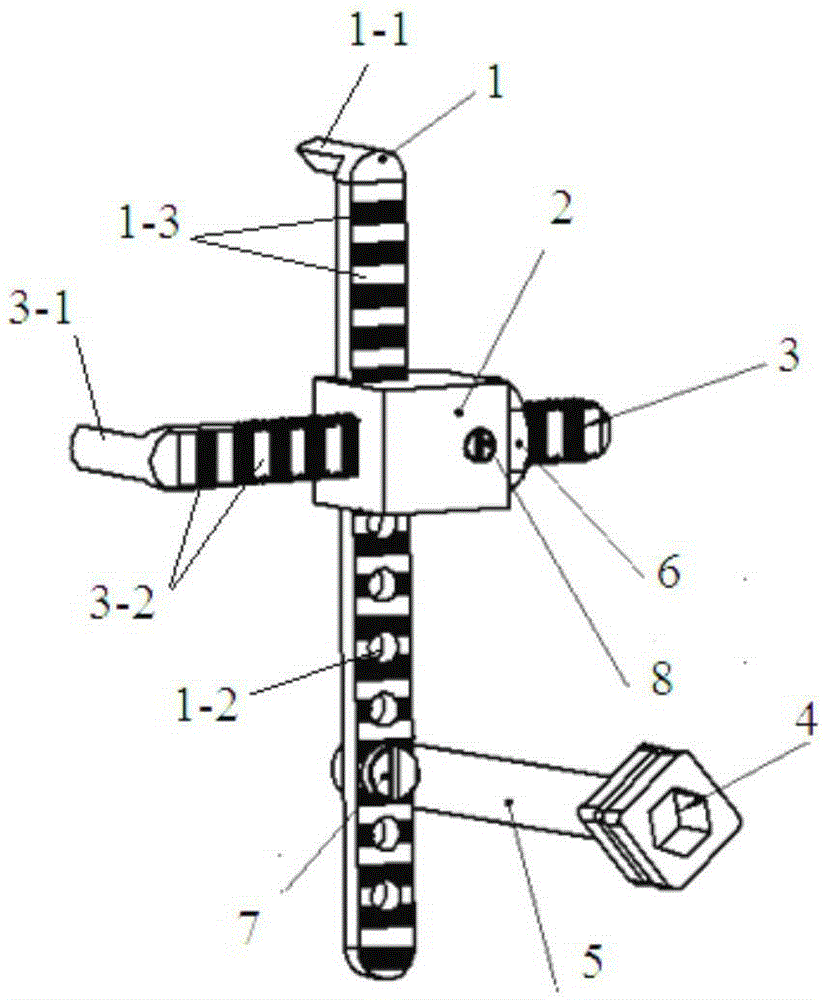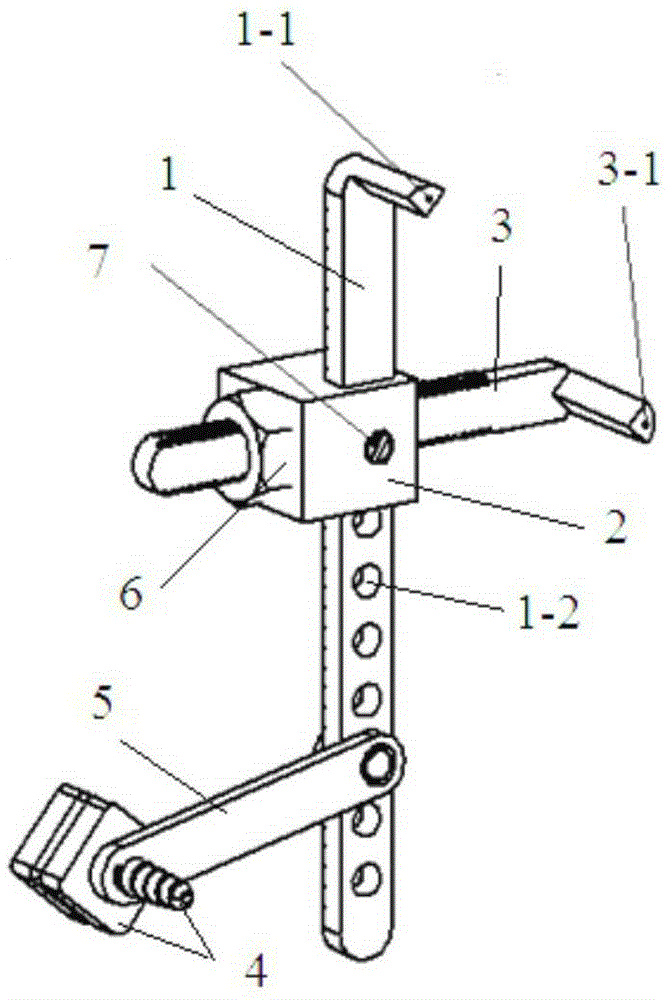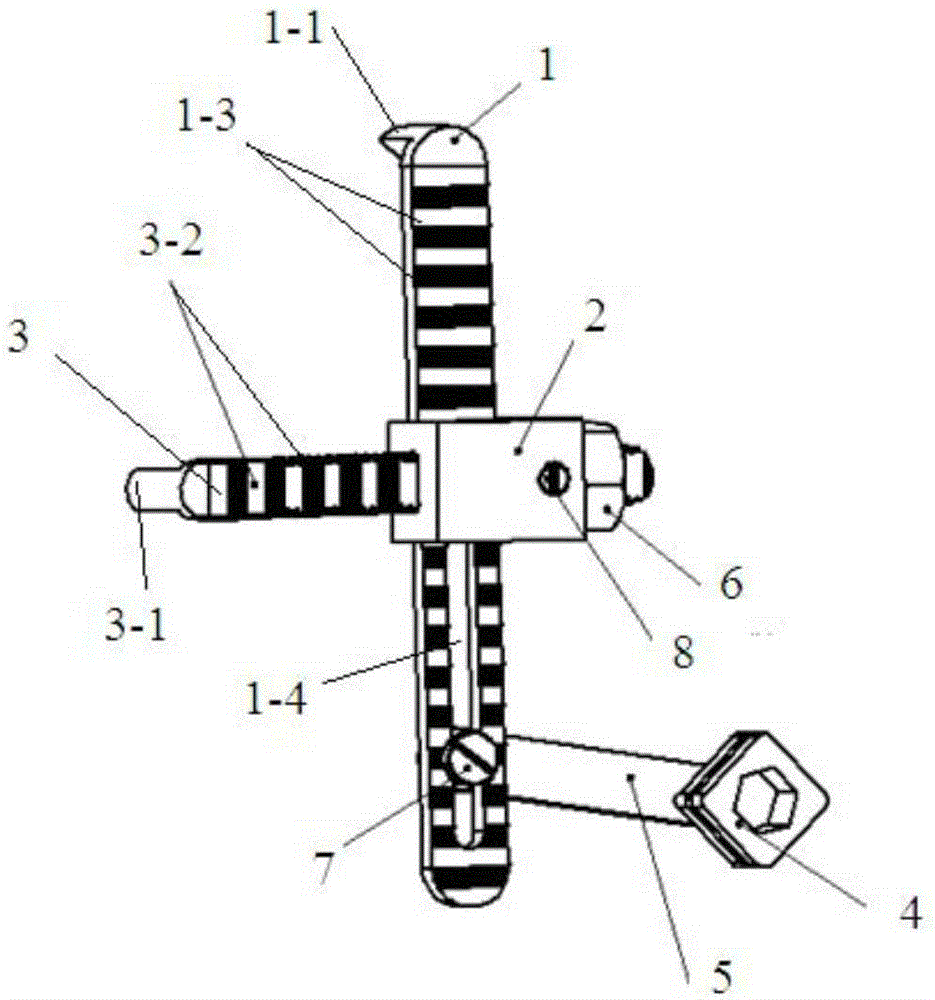Positioning device for mandibular ramus osteotomy
A positioning device and mandible technology, which is applied in the direction of surgery, stereotaxic surgical instruments, bone drill guidance, etc., can solve the problems of increasing the economic burden of patients, difficult identification of landmarks, low accuracy and efficiency, and achieve economic relief. Burden, reduction of operation time, effect of convenient combination
- Summary
- Abstract
- Description
- Claims
- Application Information
AI Technical Summary
Problems solved by technology
Method used
Image
Examples
Embodiment 1
[0050] The mandibular ramus osteotomy positioning device described in this embodiment is as follows: figure 1 , figure 2 As shown, it includes a first main rod 1, an auxiliary rod 3, a first connector 2, a positioning rod 5, a first stopper 6 and an intraosseous nail 4 for fixing during operation.
[0051] The first main rod 1 is a rod with a rectangular cross section, the back of the upper end of the first main rod is provided with an upper edge hook 1-1 positioned at the sigmoid notch 16-5 of the ascending ramus of the mandible, and the front is provided with a length Indicating marks 1-3, the lower section is provided with holes for installing positioning rods, the length indicating marks are 1mm wide strip marks with alternating light and dark, and the holes for installing positioning rods are multiple centerlines on a straight line and Circular holes 1-2 with equal spacing; the auxiliary rod 3 is a screw rod whose cross-section is surrounded by two parallel lines with t...
Embodiment 2
[0063] The mandibular ramus osteotomy positioning device described in this embodiment is as follows: image 3 , Figure 4 As shown, it includes a first main rod 1, an auxiliary rod 3, a first connector 2, a positioning rod 5, a first stopper 6 and an intraosseous nail 4 for fixing during operation. The difference from Embodiment 1 is that the holes provided on the lower section of the first main rod for installing the positioning rod are bar-shaped holes 1-4.
[0064] For the usage method of the mandibular ramus osteotomy described in this embodiment, see Figure 17 , the same as in Example 1.
Embodiment 3
[0066] The mandibular ramus osteotomy positioning device described in this embodiment is as follows: image 3 , Figure 4 As shown, it includes a second main rod 17, a guide plate 9, a first strut 10, a second strut 13, a second limiter 11, a third limiter 14, a second connector 12, and a third connector 15 And the intraosseous nail 4 that plays a fixed role during the operation.
[0067]The second main rod 17 is a rod with a rectangular cross section, the back of the upper end of the second main rod is provided with an upper edge hook 17-1 positioned at the sigmoid notch 16-5 of the ascending ramus of the mandible, and the lower end is provided with a The hole combined with the intraosseous nail is provided with a length indicating mark 17-2 on the front, and the hole combined with the intraosseous nail is a unidirectional stress hole composed of a semicircular hole 17-3 and a semiconical hole 17-4, and the length indicates The logo is a 1.5mm wide strip logo with alternati...
PUM
 Login to View More
Login to View More Abstract
Description
Claims
Application Information
 Login to View More
Login to View More - R&D
- Intellectual Property
- Life Sciences
- Materials
- Tech Scout
- Unparalleled Data Quality
- Higher Quality Content
- 60% Fewer Hallucinations
Browse by: Latest US Patents, China's latest patents, Technical Efficacy Thesaurus, Application Domain, Technology Topic, Popular Technical Reports.
© 2025 PatSnap. All rights reserved.Legal|Privacy policy|Modern Slavery Act Transparency Statement|Sitemap|About US| Contact US: help@patsnap.com



